|
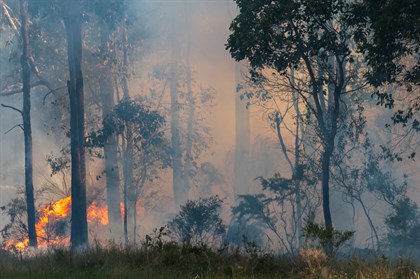
Australia has seen devastating bushfires across the country this season.
By Maxine Brain
Fires damage in two ways: burns and smoke inhalation. Burns may vary from superficial skin burns to full-skin thickness burns through to total body destruction. Those with superficial burns and a small area of full-thickness burns are the most common we deal with. Extensive full-thickness burns usually require immediate euthanasia.
Burns are classified according to the depth of the burn: first, second, third and fourth degree.
FIRST DEGREE BURNS: These are superficial skin wounds and require minimal treatment, usually in the form of cold water, topical ointments and protective covering over the wounds if practical.
SECOND DEGREE BURNS: These burns damage varying depths of the epidermis and are categorised as superficial and deep second degree burns. These often have blisters form which burst after a couple of days, leaving painful exposed skin. These require a little more intensive therapy than first degree burns with removal of burnt tissue necessary over the weeks that follow as well as gentle cleaning, topical ointments and bandaging.
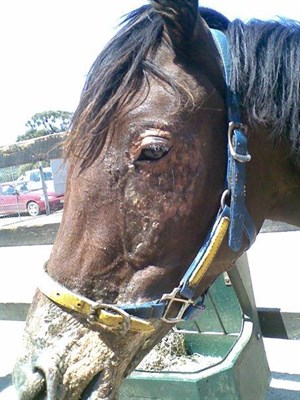
Second degree burns on the face, associated with horses running through the flames.
© Maxine Brain
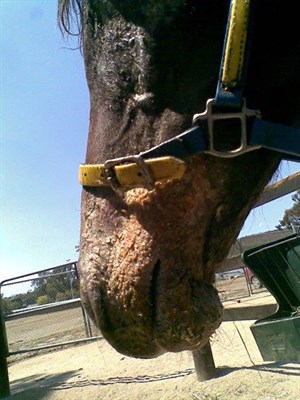
Second degree burns on the face.
© Maxine Brain
THIRD DEGREE BURNS: These involve the epidermis and the dermis and expose the horse to more life-threatening issues such as heat and fluid loss. They require frequent debridement and cleaning and expose the horse to secondary infections. The wounds will heal with scarring and can require skin grafts or commercially available skin coverings to assist healing.
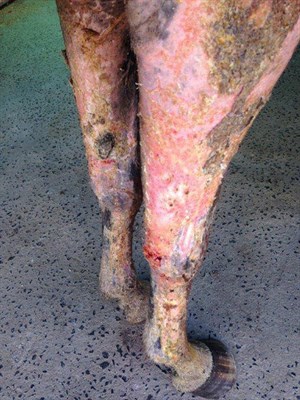
This horse has extensive second and third degree burns.
© Maxine Brain
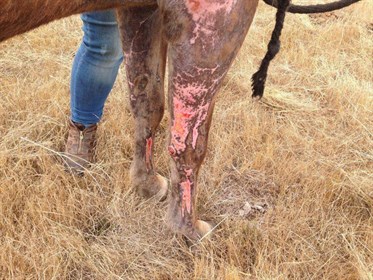
The same horse a couple of months later.
© Maxine Brain
FOURTH DEGREE BURNS: These are burns that go right through the skin and involve burning of the muscle, ligaments, tendons and bone. The degree of destruction and the internal structures damaged will determine whether the animal can survive or not.
Burns are very painful, and most horses will require pain relief of some kind. Non-steroidal anti-inflammatory drugs such as phenylbutazone/flunixin are suitable in the less severe cases but those with third and fourth degree burns, or large areas of deep secondary burns, may require stronger medications such as butorphanol, lignocaine or ketamine drips. The use of antibiotics is controversial, however, I have often used them in cases where secondary infections were suspected and had good responses.
The extent of the burn (percentage of body burnt) combined with the degree of burn (first, second, third or fourth) will determine whether treatment is feasible or if euthanasia is the kinder option.
Horses with significantly large areas (over 50%) of deeper burns (deep second, third and fourth degree burns) often require euthanasia. Burn victims endure significant pain and are susceptible to secondary infections, so when large areas are involved the associated cost and time involved can become astronomical with some cases taking years to resolve. As a rough estimate of how to judge the percentage of area involved, front legs are accessed as 9% of the body, hindlimbs 18% and each side of the body as 18% each (or 18% each for the thorax and 18% for the abdomen). The head and neck are accessed as 9%.
The most common sites for burn injury that I have seen following bushfires would be around the face and on the lower limbs, presumably as a result of horses running back through the flames to safety. It is important that the eyes are checked for injury to the corneal surface as damage to the eyes can cause blindness. The feet should also be closely assessed, as severe damage to the coronary bands or sustained heat to the feet can result in sloughing of the hoof walls. Horses that show extensive damage to the coronary bands and movement of the hoof wall independently from the foot should be euthanised, however, I would not euthanise a horse just based on damage to the coronet band alone, as some of these do grow new hoof.
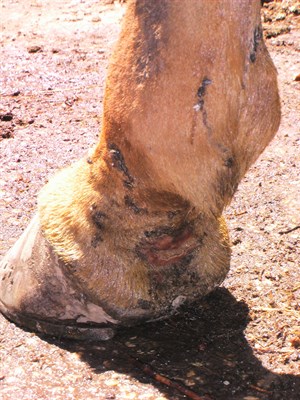
This is a pastern with a fourth degree burn, through the skin and into the tendon sheath.
© Maxine Brain
Smoke inhalation is less of an issue in open-air fires compared to those seen in closed spaces (for instance in barn fires) but the heat and inhalation of smoke particles into the lungs can cause serious issues in horses that do not appear to have any burns on their bodies. These horses develop deep coughs and can display dirty nasal discharges and high temperatures. They should be monitored carefully as they can develop pneumonia and need to be assessed by a veterinarian as soon as practical.
Whilst not directly related to thermal or smoke injury, the other injuries commonly seen with bushfires are cuts from branches and wire (damaged fences) as a result of horses running blindly through areas to escape the fires. These wounds also need to be treated as they are usually contaminated with dirt and fire particles and readily become infected if not cleaned and treated as required.
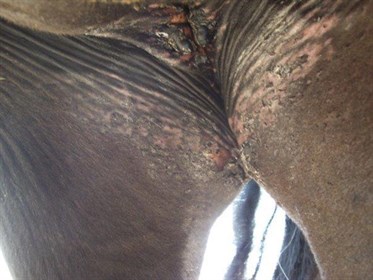
Areas of the body without hair are more sensitive to the fire, for example the udder and under tail.
© Maxine Brain
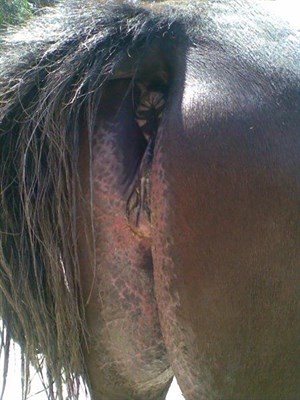
Areas of the body without hair are more sensitive to the fire.
© Maxine Brain
WHAT TO DO IF YOU STAY
If owners remain on their property, once the fire passes through they should check their horses to see if they have been burnt or injured. If the horses have suffered burns, the best course of action is to apply copious amounts of cold water to the areas. This is simpler than it sounds as often hoses, tanks or power to obtain water have been destroyed in the fire; however, if a source of water can be utilised then do. Most people will not have access to medications during this time, but if they are in possession of water-soluble topical creams and bandages then these can be applied until veterinary help can be obtained. Horses with catastrophic injuries and/or burns should be euthanised as quickly as possible. If horses are insured and injuries require immediate euthanasia, then taking photographs on your phone as a record of the severity of the injuries will help when dealing with the insurance company.
Horses that have sustained burns will require a high-quality diet, with increased nutrient and energy content as their metabolic requirements increases. This can be difficult to achieve in horses that have burns around their muzzles or horses that are in too much pain to eat. Compounding the problem is that all the pasture is gone, so horses are reliant on hand-feeding for all their daily requirements. It is important to remember that sudden changes in the diet can cause gut issues, so if bushfire survivors are provided with new feeds (donations) then introduce these feeds slowly, even though the desire is to want to get the horses eating full feeds.
If living in an area where bushfires are even a remote possibility, it is paramount to have a plan that has been carefully thought out and discussed with all relevant parties so that in the unlikely event the worst happens, no time is lost thinking about options.
1. On days when a high fire alert is issued for your area, decide if you will keep your horses at the property or evacuate them to another area where the likelihood of fire is low. This may be a large communal area like a racetrack or football ground, or it could be at a family or friend’s property. It is important to remember that if the plan is to evacuate the horses that the animals are trained to get onto a float or transport truck and that a float or truck is readily available and fuelled up.
2. If horses are to remain on the property then move them to large cleared paddocks where there is minimal vegetation, low-cut grass or cleared areas. Some people have “safe” paddocks where they have used fire breaks around the boundaries and had the grass eaten out or mowed so there is very little combustible material around. Open the internal gates so horses can move freely about the property. Do not open gates to the road — horses that escape onto the road area are at high risk of being injured or causing injury or death to people. Some people choose to cut internal fencing, particularly when the fire is close, to maximise the space available for a horse to flee. Once again, do not cut through external fences and allow access onto public roads.
3. Do not try and restrain your horse or stay with it during the fire; you risk injury or death to yourself as well as compromise the horse’s ability to save itself.
4. If possible, put horses into areas where they will have access to water once the fire passes. Large dams are ideal but large concrete water troughs can also provide water supplies in the hours and days after the fire. Water troughs that are plastic or rely on power to fill are unreliable as they may melt or become disabled. When animals remain but their owners evacuate, it can be days before anyone is allowed back to these properties, so it is reassuring to owners if they know there is water available if the property has burnt.
5. Do not lock horses up in small yards or in stables as they cannot escape the flames. Many horses will flee the flames and find the safest part of the paddock to be in. During the fires many horses would, when cornered, turn and run straight through the flames to safety in areas already burnt. Unfortunately, in the large bushfires where the areas are heavily treed, the intensity of the flames and depth of the fire makes an escape nearly impossible.
6. Remove flammable items from the horse such as synthetic head collars, fly masks or rugs. Whilst leather collars are much safer, buckles and metallic items can cause severe burns so should not be left on the horse. Rugs may help with radiant heat, however, if they catch fire, they are attached to the horse and will cause severe burns so are better left off.
7. Make sure horses have some form of permanent identification so if they escape and become lost someone can identify them and reunite them with their owners. Microchipped horses or those branded have a good chance of being located provided there are up-to-date details with owner’s names and contact details available on a central database. If horses are neither microchipped nor branded, then writing details with some form of permanent marker (permanent pen, liquid paper, paint, crayon) can be used to leave name and phone number. Phone numbers can be clipped into hair coats or tags can be plaited into manes. Care must be taken with attaching tags as they cannot be flammable or metallic.
8. Carry with you details of your horse and its markings, brands or microchips so they can be used to identify your horse.
9. Think about plaiting tails and manes or clipping these areas to reduce the risk of burning branches getting stuck in their tail and burning flanks or legs.
CFA Victoria has some very good brochures available dealing with preparing your property for fires and planing for your horses. You can find out more by visiting cfa.vic.gov.au
READ THE LATEST NEWS ARTICLES HERE

|

